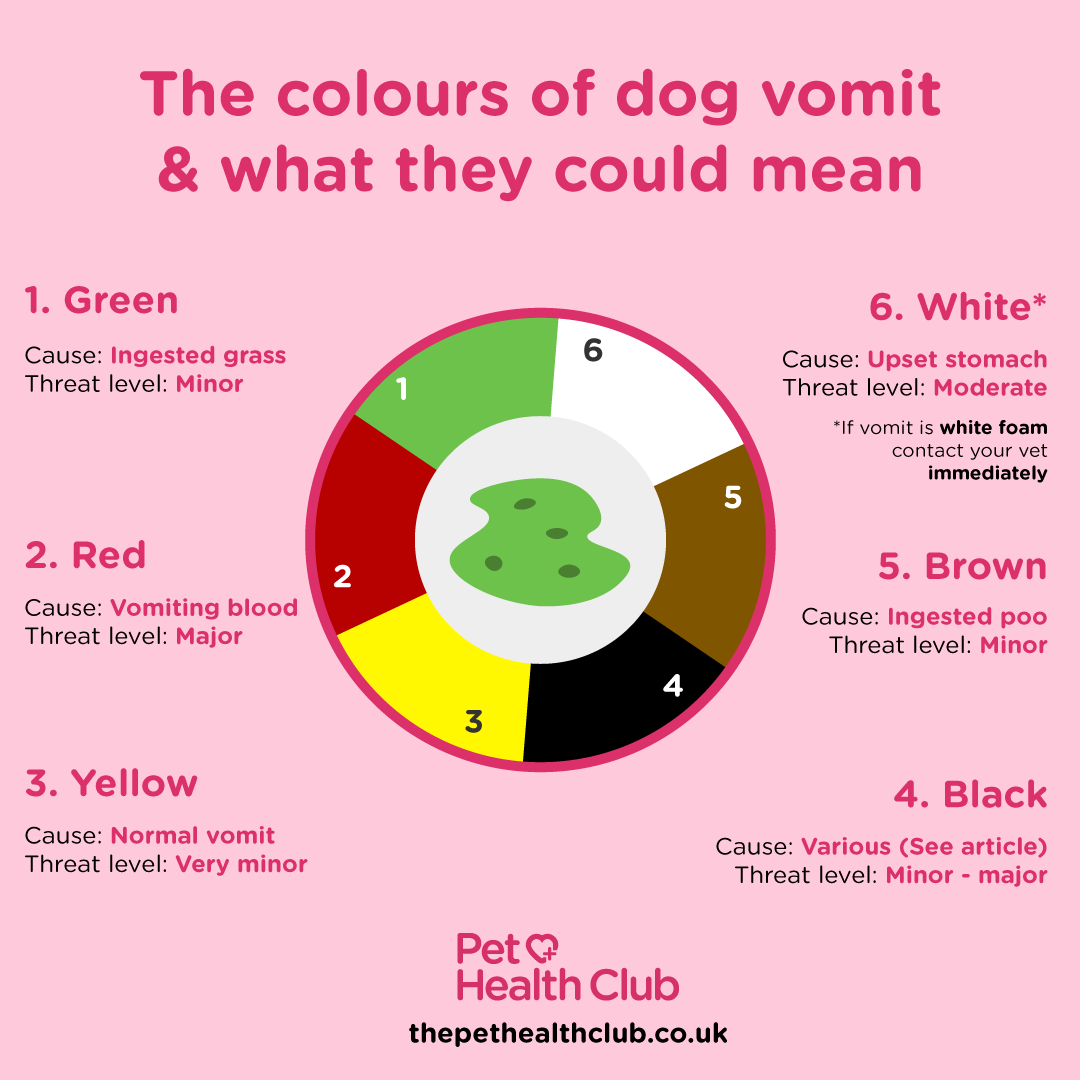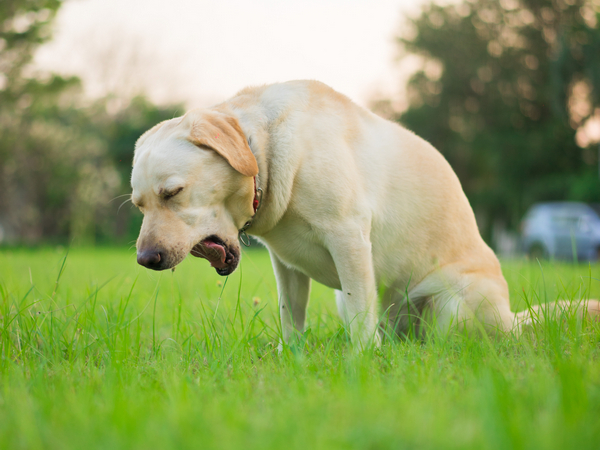Why is my dog being sick and what does the colour of my dog’s vomit mean?
First Published: 09/05/2019
Last Updated: 15/04/2024
Seeing your dog vomit can be worrying, but the colour of the vomit can give you clues about what’s wrong. This guide, and our dog vomit colour chart below, will help you understand what different vomit colours might indicate, and when it’s time to call the vet.
Vomiting isn't just about your dog being sick — it's an important sign that could indicate potential health issues. Whether it's green, yellow, or a more alarming color like black or red, each hue provides insights into potential conditions affecting your dog or puppy.
Why is my dog being sick?
If your dog is sick once and is otherwise alert, active, and showing no other symptoms, there’s likely to be nothing to worry about. If your dog is lethargic, persistently vomiting, has diarrhoea, loses their appetite, or displays any other symptoms, don’t delay — contact your vet, fast. Prolonged vomiting can quickly lead to dehydration, so always be vigilant. Your vet will help you establish the cause and recommend any necessary treatment. Always seek help from your vet if your dog or puppy keeps being sick, if you suspect they’ve been in contact with a toxic or harmful substance, or if you spot blood in their vomit. Other concerning signals are bloating, recurrent vomiting, retching, white foam or in your dog’s vomit and vomiting water.
Dog vomit colour chart
Just like humans, the colour of our dogs’ vomit can – and will – change depending on the cause. Some of these you may be expecting; others could be something of a shock.

Dark green vomit
Dogs’ vomit may be dark green if they’ve ingested a large quantity of grass. It could also mean that they’re just vomiting up bile.
What to do: Dark green vomit is rarely a cause for concern if it's a one-off. However, keep an eye on your dog if they produce green vomit - if they also seem unwell or if vomiting continues, contact your vet as soon as you can.
Read more: Why do dogs eat grass?
Yellow vomit
Yellow vomit is usually nothing to worry about, if it is a one off. Typically, it will consist mainly of bile but in a lesser quantity than in green vomit.
What to do: Clean up, but don’t worry too much unless symptoms persist. If they do, contact your vet.
Read more: Dog vaccinations: keeping your puppy happy and healthy.
Black vomit
This is rare. Typically, black vomit could be a sign of mud or dirt that your dog digested accidently while they were playing. If black vomit has a similar appearance to coffee granules, look at it closely; if you find that it’s actually a very, very dark red, this may be a sign of a stomach ulcer or an undigested toxin.
What to do: If you spot that the vomit is a very dark red rather than black, take your dog to see the vet as soon as you can.

White vomit (including white foam)
Your dog may appear to be producing white vomit but in many cases, they could simply be vomiting white foam.
If it’s vomit… the likely causes will be an upset stomach, perhaps brought about from ingesting a small amount of grass. If your dog produces white vomit and you know they haven’t eaten in a while, they could be vomiting up bile from their stomach.
If they're vomiting white foam… your dog is likely suffering from bloat or gastrointestinal problems. In these cases, they may be trying to vomit but not having much luck. This is classed as an emergency and will need immediate veterinary attention.
What to do: If it’s vomit, keep an eye out to see if symptoms persist and contact your vet if they do. If your dog is coughing up white foam, contact your vet as soon as you can.
Red vomit
Red vomit is usually a sign that your dog is vomiting blood. If the blood is fresh (a normal shade of red), this could mean trouble with the lining of their stomach or possible inflammation; alternatively, vomiting blood could be a response to a poisonous substance.
If blood is dark red, it has likely been in your dog’s system for a long time. This could be a sign of an ulcer.
What to do: If your dog is throwing up blood repeatedly or for a long period of time, contact your vet right away.
Read more: Protecting your dog from common poisons
Dark brown vomit
More often than not, dark brown vomit, especially if it smells strongly, is a sign that your dog has ingested too much poo.
It can also be a sign that there’s a blockage in their intestines.
What to do: if symptoms carry on or if your dog vomits excessively, it could be a sign of a blockage in their intestines. If in doubt, contact your vet.
Read more: Dog poo guide: what colour is your dog's poo?
Difference between vomiting and regurgitation
Regurgitation is when a dog throws up undigested food. It often occurs soon after they’ve eaten and the regurgitated material will likely be visibly different to vomit. Dogs tend to regurgitate food without warning.
It’s important to recognise the difference between regurgitation and vomiting as they may be signs of different conditions. More often than not, you know it’s vomit because the dog will display warning signs such as retching noises and a contraction of their ribs and tummy.
Common causes of dog vomiting
An infestation of worms, such as roundworm or tapeworm, can cause your dog to vomit. As always, prevention is better than cure, and it’s important to get into a regular worming routine to keep your dog worm free. If your dog has a particularly sensitive stomach they may be unable to tolerate certain foods, and this can trigger vomiting. Have you changed your dog’s diet? Your vet can advise you on a suitably bland diet – such as chicken with rice, or fish with pasta – for dogs with a sensitive stomach.
Stomach infections (gastritis) are a common cause of sickness in dogs – and are often marked by both sickness and diarrhoea. A bland diet (see above) and plenty of water can help clear up the problem in a few days, but always consult your vet if your dog doesn’t recover quickly. Sickness accompanied by diarrhoea may be a sign of colitis in your dog. Colitis is often eased by feeding your dog a bland diet (see above) after 24 hours without food. A number of serious conditions can cause sickness in dogs, including congestive heart failure, disease of the central nervous system, cancer, liver and kidney diseases.
Your vet will test your dog to rule out these conditions if necessary, and to establish the best course of treatment to get your dog back in tip-top health. Ingesting poisonous or harmful substances can cause your dog to be sick. If you believe your dog has come into contact with a toxic substance, get him to your vet as quickly as possible.
To summarise, lots of things can cause sickness and diarrhoea in dogs, including:
- Worms (including tapeworm, roundworm and lungworm)
- Gastroenteritis (inflammation of the stomach) and other stomach conditions
- Chocolate poisoning (including white chocolate)
- Eating mouldy food
- Ingesting a toxic plant
- Ingestion of a foreign body
- Colitis
Need more info?
If you’re concerned about your dog vomiting, or about any other aspect of their welfare, speak to your local vet.
Find your nearest vet using our find a vet page, or speak to a vet online using video vets service.


